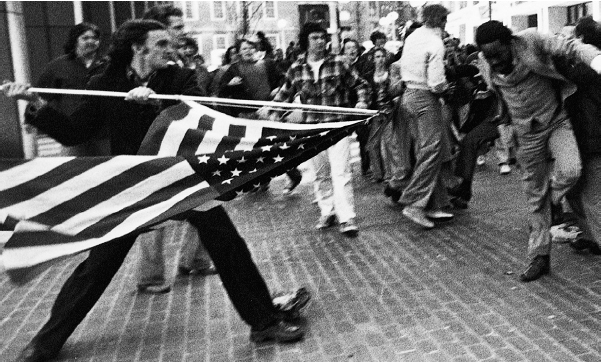America’s History: Printed Page 929
America: A Concise History: Printed Page 844
America’s History: Value Edition: Printed Page 822
The Silent Majority Speaks Out
Nixon placed himself on the side of what he called “the nonshouters, the nondemonstrators.” But moderate and conservative Americans increasingly spoke out. They were not in the mood to simply remain silent. During Nixon’s first presidential term, those opposed to the direction liberalism had taken since the early 1960s focused their discontent on what they believed were the excesses of the “rights revolution” — the enormous changes in American law and society initiated by the civil rights movement and advanced by feminists and others thereafter.
Law and Order and the Supreme Court The rights revolution found an ally in an unexpected place: the U.S. Supreme Court. The decision that stood as a landmark in the civil rights movement, Brown v. Board of Education (1954), triggered a larger judicial revolution. Following Brown, the Court increasingly agreed to hear human rights and civil liberties cases — as opposed to its previous focus on property-related suits. Surprisingly, this shift was led by the man whom President Dwight Eisenhower had appointed chief justice in 1953: Earl Warren. A popular Republican governor of California, Warren surprised many, including Eisenhower himself, with his robust advocacy of civil rights and civil liberties. The Warren Court lasted from 1954 until 1969 and established some of the most far-reaching liberal jurisprudence in U.S. history.
Right-wing activists fiercely opposed the Warren Court, which they accused of “legislating from the bench” and contributing to social breakdown. They pointed, for instance, to the Court’s rulings that people who are arrested have a constitutional right to counsel (1963, 1964) and, in Miranda v. Arizona (1966), that arrestees have to be informed by police of their right to remain silent. Compounding conservatives’ frustration was a series of decisions that liberalized restrictions on pornography. Trying to walk the fine line between censorship and obscenity, the Court ruled in Roth v. United States (1957) that obscene material had to be “utterly without redeeming social importance” to be banned. The “social importance” test, however, proved nearly impossible to define and left wide latitude for pornography to flourish.
That measure was finally abandoned in 1972, when the Court ruled in Miller v. California that “contemporary community standards” were the rightful measure of obscenity. But Miller, too, had little effect on the pornographic magazines, films, and peep shows proliferating in the 1970s. Conservatives found these decisions especially distasteful, since the Court had also ruled that religious ritual of any kind in public schools — including prayers and Bible reading — violated the constitutional separation of church and state. To many religious Americans, the Court had taken the side of immorality over Christian values.
Supreme Court critics blamed rising crime rates and social breakdown on the Warren Court’s liberal judicial record. Every category of crime was up in the 1970s, but especially disconcerting was the doubling of the murder rate since the 1950s and the 76 percent increase in burglary and theft between 1967 and 1976. Sensational crimes had always grabbed headlines, but now “crime” itself preoccupied politicians, the media, and the public. However, no one could establish a direct causal link between increases in crime and Supreme Court decisions, given a myriad of other social factors, including drugs, income inequality, enhanced statistical record-keeping, and the proliferation of guns. But when many Americans looked at their cities in the 1970s, they saw pornographic theaters, X-rated bookstores, and rising crime rates. Where, they wondered, was law and order?

Busing Another major civil rights objective — desegregating schools — produced even more controversy and fireworks. For fifteen years, southern states, by a variety of stratagems, had fended off court directives that they desegregate “with all deliberate speed.” In 1968, only about one-third of all black children in the South attended schools with whites. At that point, the federal courts got serious and, in a series of stiff decisions, ordered an end to “dual school systems.”
Where schools remained highly segregated, the courts increasingly endorsed the strategy of busing students to achieve integration. Plans differed across the country. In some states, black children rode buses from their neighborhoods to attend previously all-white schools. In others, white children were bused to black or Latino neighborhoods. In an important 1971 decision, the Supreme Court upheld a countywide busing plan for Charlotte-Mecklenburg, a North Carolina school district. Despite local opposition, desegregation proceeded, and many cities in the South followed suit. By the mid-1970s, 86 percent of southern black children were attending school with whites. (In recent years, this trend has reversed.)
In the North, where segregated schooling was also a fact of life — arising from suburban residential patterns — busing orders proved less effective. Detroit dramatized the problem. To integrate Detroit schools would have required merging city and suburban school districts. A lower court ordered just such a merger in 1971, but in Milliken v. Bradley (1974), the Supreme Court reversed the ruling, requiring busing plans to remain within the boundaries of a single school district. Without including the largely white suburbs in busing efforts, however, achieving racial balance in Detroit, and other major northern cities, was all but impossible. Postwar suburbanization had produced in the North what law had mandated in the South: entrenched racial segregation of schools.
As the 1972 election approached, President Nixon took advantage of rising discontent over “law and order” and busing. He was the political beneficiary of a growing reaction against liberalism that had begun to take hold between 1968 and the early 1970s.